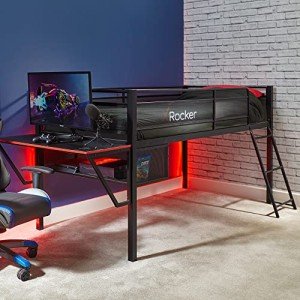The Midsleeper: A Practical Solution for Kids' Bedrooms
When it pertains to maximizing space in a kid's bed room, the midsleeper bed stands out as an innovative and functional service. Combining the raised structure of a loft bed with the ease of access of a conventional bed, midsleepers use a distinct balance of play, storage, and sleeping solutions. This short article will dive into the features, advantages, and factors to consider of midsleeper beds, using parents an extensive guide to comprehending this practical furnishings piece.
What is a Midsleeper Bed?
Midsleeper beds rise beds that normally have a sleeping area raised off the ground, but not as high as a traditional loft bed. This allows for an area below that can be utilized for numerous functions-- whether it's for storage, a play location, or a research study spot. Midsleepers normally accommodate kids and are designed with security and performance in mind.
Secret Features of Midsleeper Beds
- Height: Midsleepers are normally in between 1.2 to 1.5 meters high, making them accessible for kids while guaranteeing they are safe.
- Under-bed Space: The location below the bed is often made use of for extra furnishings or activities, including desks, wardrobes, or play locations.
- Safety Features: Most midsleepers come equipped with guardrails and ladders that comply with security requirements, offering peace of mind for moms and dads.
- Design and Customization: Available in various styles, colors, and styles, midsleepers can be tailored to fit any design, making them a flexible choice in children's furniture.
- Storage Solutions: Many midsleepers include integrated storage options, such as drawers or racks, to assist keep the bedroom arranged.
Advantages of Choosing a Midsleeper Bed
Midsleepers provide many advantages that make them a popular choice for children's bed rooms:
Space Efficiency
With the space-saving design of midsleepers, households can make use of the under-bed location for numerous purposes. This can assist keep the flooring without clutter and produce a more organized environment.
Motivation of Play and Creativity
The under-bed space motivates children to utilize their creativity. They can produce a play zone, incorporating camping tents, slides, or even a tiny castle, which promotes interactive play while making sure the room remains tidy.
Adaptability and Longevity
Midsleepers cater to kids as they grow, enabling a transition from a play location to a research study zone. The added adaptability implies that these beds can adjust to the changing requirements of a child from toddlerhood to early teenage years.
Visual Appeal
With numerous styles offered, midsleepers can improve the overall visual of a room. Moms and dads can pick styles that match existing furniture or develop a whimsical environment that stimulates a child's imagination.
Factors to consider When Choosing a Midsleeper
Despite their many advantages, there are important aspects for parents to think about when choosing a midsleeper:
- Room Size: Measure the available space in the bedroom to ensure it can accommodate a midsleeper without making the space feel cramped.
- Age and Size of the Child: Ensure that the height of the bed appropriates for your child's age and size. The majority of midsleepers are safe for children aged six and older due to their height.
- Safety Standards: Check for security certifications, guaranteeing the midsleeper sticks to regional guidelines concerning kids's furniture.
- Access and Mobility: Consider how easily your kid can access the bed. Ladders or stairs should be tough and securely attached to promote ease of use while also not being a tripping hazard.
- Style and Storage Needs: Assess your kid's choices and the required storage area. Opt for a midsleeper that matches the interior design of the space while satisfying storage requirements.
Table: Key Differences Between Various Bed Types
| Feature | Midsleeper | Loft Bed | Bunk Bed | Standard Bed |
|---|---|---|---|---|
| Height | Medium (1.2 - 1.5 m) | High (above 1.5 m) | Two beds stacked together | Low (usually ground level) |
| Under-bed Space | Yes | Yes | Yes (only one bed area) | No |
| Suggested Age | 6+ | 8+ | 6+ | 2+ |
| Safety Features | Guardrails, durable ladder | Guardrails, sturdy ladder | Guardrails | None |
| Space Efficiency | High | Extremely High | Moderate | Low |
Frequently Asked Questions About Midsleeper Beds
1. What age is suitable for a midsleeper bed?
Midsleeper beds are normally suggested for children aged 6 and older, ensuring they can safely navigate the height and structure of the bed.
2. Do midsleeper beds require special bed mattress?
Midsleeper beds generally utilize standard single or twin mattresses, however it is vital to inspect the maker's standards for specific suggestions regarding thickness or size.
3. How can I guarantee my kid is safe in a midsleeper?
To promote safety, guarantee that the bed is set up correctly, acquaint your kid with utilizing the ladder, and examine that guardrails are installed and safe and secure.
4. Can I personalize a midsleeper bed?
Yes! Many midsleepers been available in various styles and can be customized with accessories such as tents, slides, and storage solutions to match your kid's preferences.
5. Are Bunk Beds Store to assemble?
Most midsleeper beds featured uncomplicated assembly guidelines, allowing parents to set them up without professional assistance. However, it's recommended to have an additional pair of hands to assist.
Midsleeper beds provide an exceptional option for households looking for to enhance space in kids's spaces while providing a safe and fun sleeping plan. With their flexible designs, safety features, and myriad options for modification, they accommodate the needs of growing children and adapt as those requirements change. By carefully considering elements such as room size, safety requirements, and aesthetic choices, moms and dads can pick the ideal midsleeper to boost organization and encourage imagination in their child's bed room.

